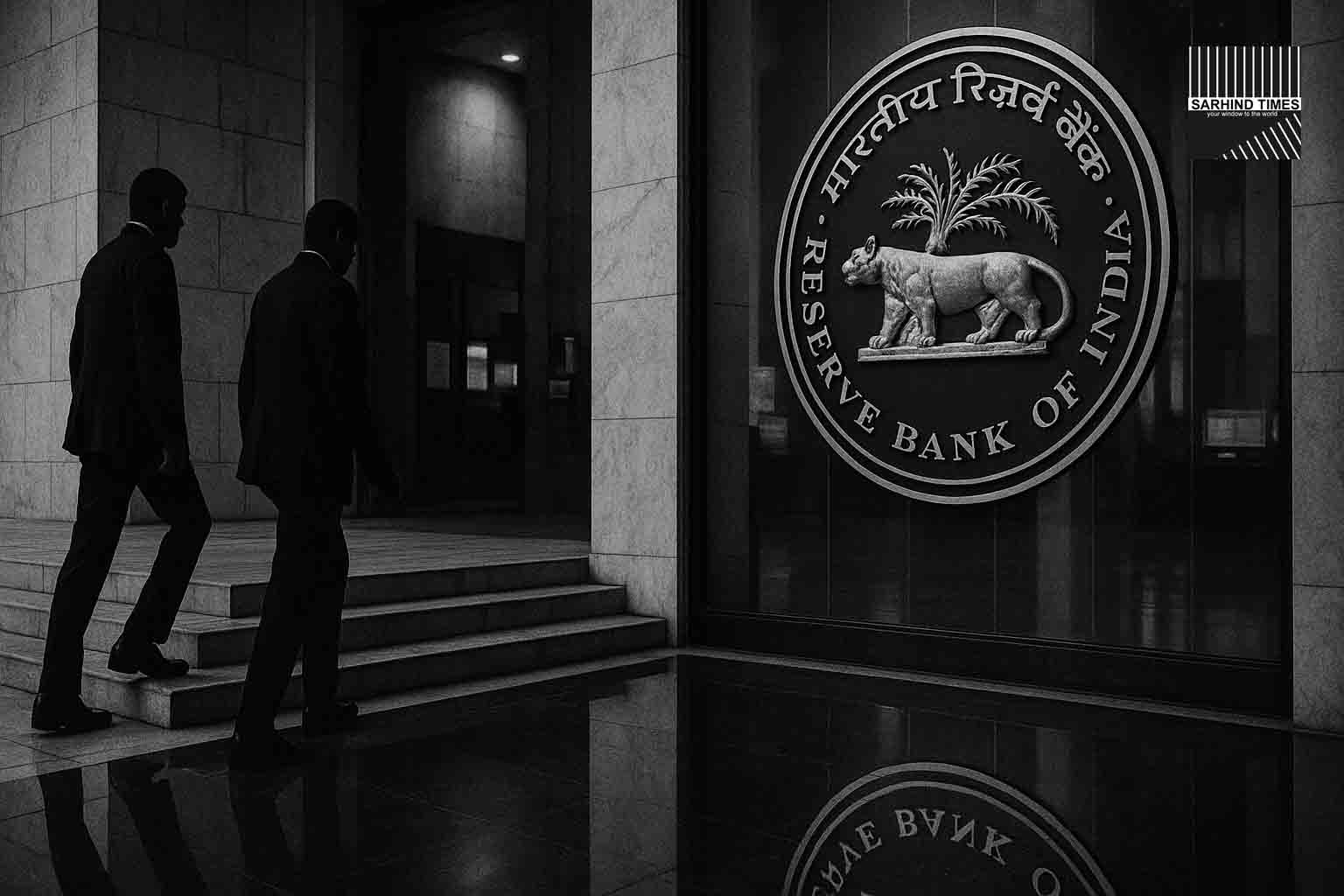As India’s central bank navigates a delicate balance between growth and inflation, the appointments of two new Executive Directors — Sanjay Kumar Hansda and Sonali Sen Gupta — bring renewed focus to continuity, expertise, and institutional depth at the Reserve Bank of India.
The Reserve Bank of India (RBI) has appointed Sanjay Kumar Hansda and Sonali Sen Gupta as its new Executive Directors (EDs). Hansda took charge on October 6, while Sen Gupta assumed office on October 9. The appointments, announced today, come at a time of critical macroeconomic transitions, with the central bank steering liquidity, currency stability, and monetary policy amid volatile global headwinds. Source: The Economic Times.
Mumbai Monday: RBI Strengthens Leadership as Monetary Vigilance Rises
Mumbai, October 13 —
The Reserve Bank of India, the cornerstone of India’s financial stability architecture, ushered in two new Executive Directors this week — Sanjay Kumar Hansda and Sonali Sen Gupta — both career central bankers known for their deep policy experience.
The move, announced today through an official communication, reflects the RBI’s ongoing institutional renewal process at a time when the global and domestic economic environment remains fluid. The appointments are not just administrative updates — they signal a recalibration of expertise within the central bank as it faces complex challenges ranging from inflation control to liquidity management, digital payments regulation, and financial-sector oversight.
Hansda and Sen Gupta now join a select group of Executive Directors who collectively guide the Reserve Bank’s multiple verticals — from supervision of financial institutions to policy formulation and systemic risk assessment.
👥 The Appointees: Profiles of Steady Hands
Sanjay Kumar Hansda
A veteran economist within the central bank ecosystem, Hansda has held several key positions in the Department of Economic and Policy Research (DEPR). Known for his analytical rigor, he has been instrumental in drafting macroeconomic reports, policy analyses, and contributing to RBI’s core research publications that inform monetary strategy.
According to RBI officials, Hansda’s elevation comes after decades of work shaping the data-driven underpinnings of policy formulation. His appointment as Executive Director is seen as a natural progression for someone deeply rooted in the RBI’s research arm, often regarded as the “brain trust” of the central bank.
Sonali Sen Gupta
Sen Gupta, who took charge on October 9, brings extensive experience from the Department of Regulation and Department of Supervision, where she has worked on bank licensing norms, prudential frameworks, and the evolving architecture of NBFC regulation.
A strong advocate of risk-based supervision and inclusive financial governance, Sen Gupta’s appointment underscores the RBI’s growing emphasis on gender diversity in leadership. She is among the few women in the central bank’s top management, following in the footsteps of leaders like Dr. Uma Shankar and Dr. P. Vijaya Bhaskar, who previously served as EDs.
Her colleagues describe her as a “bridge-builder” — equally comfortable discussing Basel norms and digital payment innovations — a quality increasingly vital in a rapidly transforming financial landscape.
📊 Institutional Continuity in Times of Change
The timing of these appointments is notable. India’s economy stands at an inflection point: GDP growth remains robust at 7.2%, inflation is easing but uneven, and global financial markets are on edge due to the “higher-for-longer” interest rate stance by major central banks.
In this context, the RBI’s leadership stability becomes crucial. Executive Directors at the central bank are more than administrators; they are policy custodians — shaping everything from how banks are supervised to how liquidity is calibrated in the interbank market.
Both Hansda and Sen Gupta are expected to be allocated significant portfolios aligned with their expertise. While the RBI has not yet disclosed departmental assignments, sources indicate that Hansda may continue influencing research and policy analytics, while Sen Gupta could oversee key segments of financial regulation and risk supervision.
💬 The Institutional Framework: How Executive Directors Shape Policy
The RBI’s governance structure is carefully layered. At its apex sits the Governor, supported by four Deputy Governors overseeing specific domains such as Monetary Policy, Financial Markets, Regulation, and Supervision. Below them, a cadre of Executive Directors leads critical departments — the operational engines that translate policy into execution.
Typical ED responsibilities include:
- Overseeing key departments (like Payment Systems, Banking Regulation, or Financial Inclusion).
- Coordinating with ministries and financial-sector regulators.
- Providing inputs for the Monetary Policy Committee (MPC) and internal committees.
- Supervising implementation of the RBI Act and Banking Regulation Act.
Thus, these appointments are not symbolic; they directly shape how India’s financial system functions — from credit flows to digital transactions.
📉 Global Context: Central Banks Under the Spotlight
Worldwide, central banks are facing a delicate balancing act — curbing inflation without triggering growth shocks. The U.S. Federal Reserve, European Central Bank (ECB), and Bank of England are all recalibrating policy amidst stubborn inflation and fiscal strains.
Against this backdrop, the RBI has distinguished itself for maintaining monetary credibility while avoiding overt tightening. The central bank’s “withdrawal of accommodation” stance, paired with targeted liquidity operations, has been praised for precision.
With two new Executive Directors in place, the RBI strengthens its bench at a time when financial stability risks — including NBFC exposure, fintech regulation, and bond-market sensitivity — demand constant vigilance.
⚙️ Macro Mandate: Stability Over Spectacle
The RBI’s near-term priorities are multifaceted:
- Anchoring Inflation: CPI is projected to moderate to around 1.7% (as per market forecasts), but food price volatility remains a concern.
- Liquidity Management: Surplus liquidity has narrowed, prompting fine-tuned variable rate repo (VRR) operations.
- Supervisory Oversight: Ensuring non-bank entities maintain prudent leverage ratios.
- Currency Stability: Maintaining the rupee’s stability amid global dollar strength.
- Digital Regulation: Expanding Unified Payments Interface (UPI) interoperability while monitoring fraud risk.
Each of these areas requires technocratic precision — exactly the kind of expertise both Hansda and Sen Gupta bring.
📚 The Road Ahead: Internal Reforms and Policy Transparency
The RBI’s internal functioning has evolved rapidly over the past decade. From establishing a Monetary Policy Committee (MPC) to digitizing its supervisory processes, the institution has embraced transparency and data analytics like never before.
Sources within the central bank suggest that Hansda’s background in policy research may help strengthen the RBI’s communication architecture — ensuring policy rationale is clearly articulated to markets and citizens. Sen Gupta’s appointment, on the other hand, may help refine regulatory clarity for digital lenders and NBFCs, particularly around issues like loan origination, data protection, and grievance redress.
These shifts reflect the RBI’s dual mandate: macroeconomic stability and consumer trust.
💡 Voices from the Financial Community
Reactions to the appointments have been positive across the banking and economic spectrum.
“This demonstrates RBI’s focus on deep institutional expertise rather than external recruitment.”
— Ananth Narayan, Professor of Finance, SP Jain Institute of Management
“Hansda’s grounding in research will enhance analytical rigor in policy design.”
— Dr. Charan Singh, Former RBI Economist
“Sen Gupta’s inclusion reinforces gender representation at senior levels — symbolic and substantive progress.”
— Shinjini Kumar, CEO, SALT Financial Advisory
The consensus: continuity and competence trump charisma in central banking — and both new EDs embody that philosophy.
🏦 The Broader Financial Ecosystem
India’s financial system today is more integrated than ever. From UPI to sovereign green bonds, the RBI’s decisions reverberate across every economic layer — households, corporations, and government borrowing programs alike.
Executive Directors thus act as crucial operational anchors ensuring the RBI’s decisions flow seamlessly from policy rooms in Mumbai’s Mint Street to every rural credit outpost in the country.
With digital transformation reshaping finance, departments like FinTech Supervision, Cybersecurity, and Payment Systems & Settlement are expected to gain more strategic prominence — areas where the new leadership will likely focus their energy.
📈 Institutional Legacy: Building the RBI of the Future
The appointments also signal the RBI’s long-term continuity planning. As several senior officials near superannuation in 2025–26, grooming a new generation of policy leaders ensures institutional memory remains intact.
Observers note that RBI’s current leadership under Governor Shaktikanta Das has prioritized strengthening the central bank’s middle management — bridging policy ideals with operational execution.
The arrival of Hansda and Sen Gupta fits this pattern perfectly — combining deep domain knowledge with policy adaptability.
🌍 Comparing Central Bank Structures: Global Parallels
Globally, central banks such as the U.S. Federal Reserve and Bank of England also rely heavily on Executive or Deputy-level directors to manage specific divisions. However, India’s model stands out for balancing technocratic expertise with policy continuity — avoiding overt politicization of appointments.
The RBI’s Executive Directors form part of an elite administrative layer that operates under tight ethical codes, extensive review mechanisms, and cross-functional coordination with ministries, regulators (like SEBI, IRDAI, PFRDA), and international bodies such as the IMF and BIS.
In that sense, the latest appointments enhance both credibility and representation in an institution that remains one of India’s most trusted public bodies.
📊 Market Implications: Stability Reaffirmed
While the appointments don’t immediately impact markets, they reinforce confidence in the RBI’s operational resilience.
Bond traders view the move as continuity-positive — indicating no sudden shifts in monetary or supervisory stance. Equity strategists, meanwhile, note that strong RBI leadership typically correlates with lower volatility in financials, especially banking and NBFC stocks.
In the words of a Mumbai-based fund manager:
“Policy predictability is the biggest alpha. These appointments reinforce that.”
📜 Inside Mint Street: The Culture of Quiet Competence
Unlike headline-grabbing corporate appointments, RBI leadership changes are often low-key — reflective of the institution’s ethos of “silence over spectacle.”
Behind the marble corridors of its iconic Mint Street headquarters, every appointment is an affirmation of a tradition stretching back to 1935: quiet stewardship over financial order.
Hansda and Sen Gupta now inherit that legacy — custodians of an institution that defines trust in India’s economy.
🔚 Conclusion: Quiet Leadership in an Era of Noise
In a world of algorithmic trading, social-media-driven markets, and geopolitical unpredictability, India’s central bank remains an island of composure.
By inducting two seasoned professionals into its Executive Council, the RBI has reinforced what truly anchors confidence in financial systems — expertise, continuity, and credibility.
The appointments of Sanjay Kumar Hansda and Sonali Sen Gupta symbolize precisely that: steady hands at the helm of India’s most trusted institution.
#RBI #Banking #MonetaryPolicy #FinancialStability #Regulation #IndiaEconomy #CentralBank #MintStreet #SarhindTimes






















+ There are no comments
Add yours